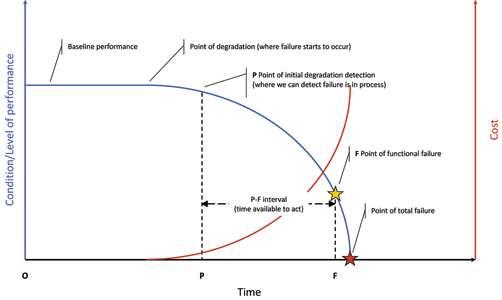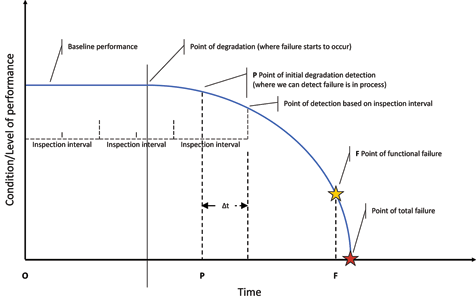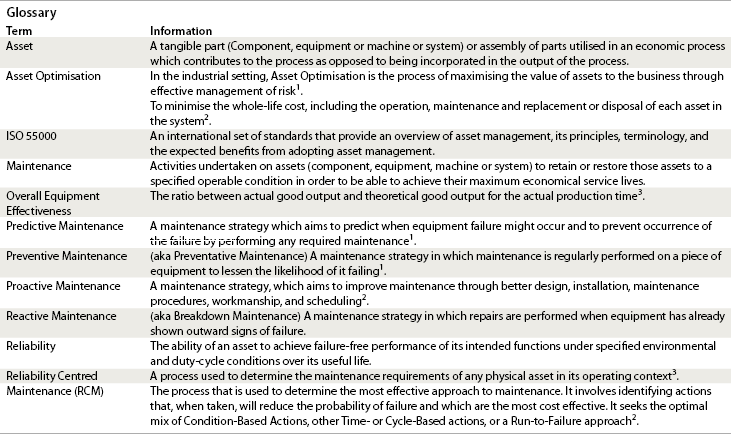
The problem is that so many of these concepts are interrelated and there are so many approaches to these topics. In this article we look at the Asset Management and Maintenance landscape and also at how changes in technology are impacting that landscape.
Why is this topical?
For an economic entity to survive and prosper in a globally competitive environment it needs to maximise its profitability – to get the most bang for its buck. That should include such aspects as maximising system throughput while minimising fixed and variable costs of production.
From a maintenance engineering perspective the ideal is to have assets, which over their economic lifecycle, are always capable of achieving their designed function (including safety, throughput or output, speed, capacity and quality considerations) and never fail in such a way that the failure has a negative impact on the maximisation of enterprise profitability. Negative impacts would include operator or user injury, death, environmental degradation, reduced throughput and failure to achieve specification of manufactured product.
Nowhere is this more important than in the aerospace industry where asset failures can have major financial consequences. And it was this industry that gave birth to the concept of Reliability Centred Maintenance (RCM).
Types of maintenance
The basic types of maintenance can be categorised as:
• Reactive (Run to failure or Breakdown)
• Preventive (Time- or cycle-based)
• Predictive Testing and Inspection (Condition-based)
• Proactive (Holistic)
(See glossary below for definitions)
Each maintenance style has its own set of associated costs and consequences. Reactive maintenance will result in major consequential repair costs, a requirement for higher investment in spares and more unscheduled downtime. Preventive maintenance may result in higher costs for lubrication and filter replacement, but not require such a high investment in spares, while offering higher asset utilisation. Predictive maintenance might involve investing in expensive test and monitoring equipment, but offer the highest asset availability.
There are differing statements regarding the cost-effectiveness of each of these maintenance strategies, but general consensus on their order is shown in Table 1.

One of the downsides of following a purely Preventive Maintenance approach is that multiple studies2,3 have shown that age-related failure (which is essentially the failure pattern that Preventive Maintenance addresses) is responsible for between only eight and 23% of failures, the remaining nine-two to 77% of failures have a more random distribution.
A second disadvantage of applying Preventive Maintenance is that every time an asset is repaired, it is may be subject to infant mortality, depending on its typical pattern of failure.
Reliability Centred Maintenance
For any asset in a particular operating environment there exists an optimum economic mix of the basic maintenance approaches. One methodology used to find the optimum maintenance activities for an asset is Reliability Centred Maintenance, which has been developed to address the multitude of reliability issues with the aim of improving Overall Equipment Effectiveness while controlling asset Lifecycle Cost.
There are whole books and a Society of Automobile Engineers standard4 written on RCM, but in brief, it is a criticality- and risk-based approach which involves assessing each asset in terms of the following seven questions5 to arrive at an optimum maintenance regime, which will avoid or minimise the consequences of failure of that asset:
1. What are the functions and associated performance standards of the asset in its present operating context?
2. In what ways does it fail to fulfil its functions?
3. What causes each functional failure?
4. What happens when each failure occurs?
5. In what way does each failure matter?
6. What can be done to predict or prevent each failure?
7. What should be done if a suitable proactive task cannot be found?
In the real world, failure is a process, not an event. The stages of failure can be represented in the P-F curve (Figure 1), a key tool in understanding Reliability Centred Maintenance. In the figure, the left-hand vertical axis represents condition or level of performance and the horizontal axis denotes time. The P-F curve is shown in blue. When the asset is first commissioned (O) it has a measurable baseline level of performance. At some point in time it starts to fail in an undetectable way. At a later point in time (P), the failure becomes detectable through some reliable test or monitoring equipment (acoustic, thermal, vibration...) and subsequently, if there is no intervention, the asset starts to show obvious signs of distress (smoking, shaking, squealing...). It reaches a state of functional failure (F), where it stops safely performing the function for which it was used, before it finally fails completely. As these last stages are reached the failure results in significant unplanned system downtime and consequential losses.

As depicted by the red curve in Figure 1, the consequential cost of failure or impending failure will typically rise as the point of final failure is approached.
RCM is based on the principle that the P-F interval for an asset under a defined set of operating conditions can be determined, and then introduces the concept of an inspection interval which is less than the P-F interval (typically equal to half of the P-F interval). On that basis, the inspection or test that is capable of detecting the impending failure will be performed before the point of failure (F) (Figure 2), allowing time for maintenance to be planned (actions prioritised and planned, spares secured and repair work executed) before functional failure.

Continuous condition monitoring
The inspection(s) or test(s) that are applied at the inspection interval referred to above have traditionally been applied by maintenance personnel performing machine inspection; testing with handheld instruments and recording the test results on paper or electronically. Although this periodic inspection and testing can be performed either off-line or on-line, the latter is generally preferred because it involves less or no productive downtime of the asset.
As can be seen from Figure 2, depending on the phasing of the periodicity of the inspection interval, the point of detection of an impending failure based on the inspection schedule will be some time (Δt) after the earliest possible point of detection of the impending failure. Indeed, this elapsed time will have a value somewhere between zero and the inspection interval.
With assets that are critical to production, many technologies (Table 2) are now available for continuous, rather than periodic, on-line monitoring of the physical phenomena that are indicative of incipient failure. Referring back to Figure 2, the implication of continuous on-line monitoring is that the variability of Δt can be eliminated and its value becomes the sampling / reporting period of the applied on-line condition-based monitoring instrument or system, which will typically be in the order of minutes or tens of minutes rather than days or weeks.

Virtual instruments and analytics
As technology develops and continuous monitoring systems become smarter and more powerful, manufacturers are developing algorithms that utilise a combination of analytics, inputs from multiple on-line sensors and advanced pattern recognition to create virtual instruments which have the effect of moving the point of initial degradation detection P, back up the P-F curve (refer Figure 2), closer to the (undetectable) point of degradation. A maintenance approach using such multiple variable and analytics is classified as Proactive Maintenance.
Continuous condition monitoring, virtual instruments and analytics help to minimise and eliminate the variability of Δt, which means that:
• The maintenance engineering discipline has more time and flexibility to manage an impending failure event
• The risk of the event leading to undesirable outcomes is minimised
• The consequences of the event are minimised
Drivers of change
Today there are multiple trends which are contributing to more effective asset maintenance. These trends include:
• The growth in MEMS and nano-sensor technology and manufacturing volumes, driven in no small part by the ubiquitous smartphone
• The growth in the adoption of industrial wireless sensor networks and sensor networks such as ZigBee
• Initiatives like the Industrial Internet of Things and Industrie 4.0 that promote the application and exploitation of pervasive, continuous sensing and broad availability of data
Challenges
Traditionally there have been companies that have specialised in particular condition-based monitoring phenomena. When it comes to vibration and balance companies like Bently Nevada and SKF come to mind. For thermal imaging names like FLIR and Fluke stand out.
These companies, and many others, each have instruments and on-line systems that can be used for the early detection of asset failure. Instrument vendors like Endress+Hauser have calibration systems and instrumentation asset management systems that can help to monitor both production asset health and instrument / instrument network health. Systems like SAP have asset management modules.
But to maximise the potential of on-line condition-based monitoring all of this data (continuous condition data, process data and utilities data) needs to be in one place so that users can view an asset’s performance history and current status holistically and so that more detailed algorithms and models can be derived to provide the earliest possible notification of impending asset failure. A full list of article references and resources can be found at http://www.instrumentation.co.za/51584n

Glossary references
1. Maintenance Assistant, https://www.fiixsoftware.com, [2015-03-27]
2. NASA, http://www.hq.nasa.gov , [2015-03-27]
3. John Moubray, Reliability-centred Maintenance, 1991
About the author

Andrew Ashton has electrical, mechanical and business qualifications and has been active in automation and process control since the early 1980s. Since 1991 he has headed up a company that has developed formulation management systems for the food, pharmaceutical and chemical manufacturing industries and manufacturing solutions involving the integration of various communication technologies and databases. Developed systems address issues around traceability, systems integration, manufacturing efficiency and effectiveness. Andrew is a contributing editor for SA Instrumentation and Control.
| Tel: | +27 11 543 5800 |
| Email: | malckey@technews.co.za |
| www: | www.technews.co.za |
| Articles: | More information and articles about Technews Publishing (SA Instrumentation & Control) |

© Technews Publishing (Pty) Ltd | All Rights Reserved